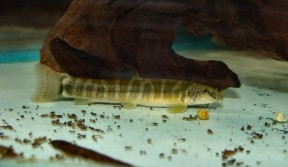Schistura sp. 2
Laos Redtail Loach
Etymology
Schistura: from the Greek schizein, meaning ‘to divide’, and oura, meaning ‘tail’, in reference to the caudal-fin shape of many species.
Classification
Order: Cypriniformes Family: Nemacheilidae
Distribution
Unconfirmed; this fish is supposedly exported from Laos.
Maximum Standard Length
Expect it to reach at least 40 – 45 mm.
Aquarium SizeTop ↑
Minimum base dimensions of 80 ∗ 30 cm or equivalent should prove sufficient.
Maintenance
Not difficult to maintain under the correct conditions; we strongly recommend keeping it in a tank designed to resemble a flowing stream or river with a substrate of variably-sized rocks, sand, fine gravel, and some water-worn boulders.
This can be further furnished with driftwood branches arranged to form a network of nooks, crannies, and shaded spots, thus providing broken lines of sight. While the majority of aquatic plants will fail to thrive in such surroundings hardy types such as Microsorum, Bolbitis, or Anubias spp. can be grown attached to the décor.
Though torrent-like conditions are unnecessary it does best if there is a high proportion of dissolved oxygen and some water movement in the tank meaning power filter(s), additional powerhead(s), or airstone(s) should be employed as necessary.
Like many fishes that naturally inhabit running water it’s intolerant to accumulation of organic pollutants and requires spotless water in order to thrive, meaning weekly water changes of 30-50% tank volume should be considered routine.
Water Conditions
Temperature: 20 – 26 °C
pH: 6.0 – 7.5
Hardness: 36 – 215 ppm
Diet
Likely to feed on small insects, worms, crustaceans, and other zooplankton with only relatively small amounts of plant matter and other organic detritus consumed.
In the aquarium it will accept dried foods of a suitable size but should not be fed these exclusively, and daily meals of small live and frozen fare such as Daphnia, Artemia, bloodworm, etc., will result in the best colouration and condition.
NotesTop ↑
The identity of this fish is unclear but it has been traded as S. sp. ‘Laos redtail’.
Schistura is the most species-rich genus among nemacheilid loaches with some 190 members and it continues to grow with over 100 having been described since 1990. It may represent a polyphyletic lineage and is often arranged into a number of loosely-defined species ‘groups’, some of which are quite dissimilar to one another.
Among these are an assemblage in which some or all of the body bars are vertically split and another which exhibit reductions in body size (adult size <50 mm SL), the number of pelvic and pectoral-fin rays and often the number of caudal-fin rays and lateral line length, for example.
Some species, such as S. geisleri, also appear to be unrelated to any of the others.
Most inhabit flowing streams or areas close to waterfalls where there naturally exist high concentrations of dissolved oxygen, and a handful are troglobytic, i.e., cave-dwelling, in existence. The latter have reduced pigmentation and are completely blind in many cases.
Schistura spp. are distinguished from other nemacheilids by a combination of morphological characters which include: a moderately arched mouth which is 2-3.5 times wider than it is long; a median ‘interruption’ in the lower lip which does not form two lateral triangular pads and can vary from smooth to furrowed in texture; diverse colour pattern but usually dark with relatively regular bars; usually a black bar at the caudal-fin base which can be broken into two spots or smaller bars; one or two black markings along the base of the dorsal-fin; lack of acuminate scales on the caudal peduncle; caudal-fin shape variable from truncate to forked but usually emarginate; presence or absence of a median notch in the lower jaw; clear sexual dimorphism in some species.
The family Nemacheilidae is widely-distributed across most of Eurasia with the Indian subcontinent, Southeast Asia and China representing particular centres of species diversity.
References
- Kottelat, M., 1990 - Verlag Dr. Friedrich Pfeil, München: 1-262
Indochinese nemacheilines. A revision of nemacheiline loaches (Pisces: Cypriniformes) of Thailand, Burma, Laos, Cambodia and southern Viet Nam. - Kottelat, M., 2012 - Raffles Bulletin of Zoology Supplement 26: 1-199
Conspectus cobitidum: an inventory of the loaches of the world (Teleostei: Cypriniformes: Cobitoidei). - Kottelat, M., 2001 - WHT Publications, Colombo: 1-198
Fishes of Laos. - Tang, Q., H. Liu, R. Mayden, and B. Xiong, 2006 - Molecular Phylogenetics and Evolution 39(2): 347-357
Comparison of evolutionary rates in the mitochondrial DNA cytochrome b gene and control region and their implications for phylogeny of the Cobitoidea (Teleostei: Cypriniformes). - Šlechtová, V., J. Bohlen and H. H. Tan, 2007 - Molecular Phylogenetics and Evolution 44(3): 1358-1365
Families of Cobitoidea (Teleostei; Cypriniformes) as revealed from nuclear genetic data and the position of the mysterious genera Barbucca, Psilorhynchus, Serpenticobitis and Vaillantella.


